Traffic flows

The flow of traffic is like the flow of water. Just as when two or more streams meet there is turbulence, so the risk of accidents goes up when traffic intersects. The more streams cross the more the risk, so a side turn merge with one traffic stream is less risky than an intersection where many streams meet. The following diagrams were created with accidentsketch.com. If you drive on LEFT look at the LEFT diagram, and if you drive on the RIGHT look at the RIGHT diagram! The terms used to describe the cross-flow cases are:
- Merge: Merging with a traffic stream.
- Cross: Crossing a traffic stream.
- Side: Side entry to a traffic stream.
Cross-traffic turn

In the diagram. The red motorcycle M wants to turn across the flow of traffic as per the dotted line. A green car A is coming the other way. There is a yellow truck T behind and a yellow car AA also waiting to cross.
Note. The dots in the center of the intersection indicate gravel that often builds up where no cars ever go. Avoid it!
- Move to the center line, avoiding the gravel build up in the center. This lets the truck behind continue safely.
- Wait at point O for the oncoming car(s) to pass. This position also allows the yellow AA car to cross around behind you if they want.
- Move across to complete the turn when clear. At no point are you blocking any traffic flow.
Car pulls out of side-road
In this surprisingly common accident situation, a car pulls out of a side road into your path. You can hit the side of the car, possibly going over the bonnet.

In the diagram. The red motorcycle has right of way. A green car doesn’t see the motorcycle and pulls out in front of it.
- Slow Down and Get Ready because it is an intersection.
- Move to the center of the road to give more space.
- Confirm the car sees you and is fully stationary. If it moves in any way, flash your beam and prepare to stop with horn.
Notes. Some say one can do nothing if a car randomly pulls out but this is not true. Car drivers can be distracted, careless and in a hurry, but they are not random. A car stationary at a Yield sign will not pull out if it sees you. Moving to the center and flashing increases visibility and the closer you get the more likely they will see you. In good weather you can see them looking at you. On the other hand, if they are still moving be prepared to stop.
Car pulls out of blind spot
In this case the side road has two lanes, and the car pulls out of a blind spot behind a van in front of the motorcycle.
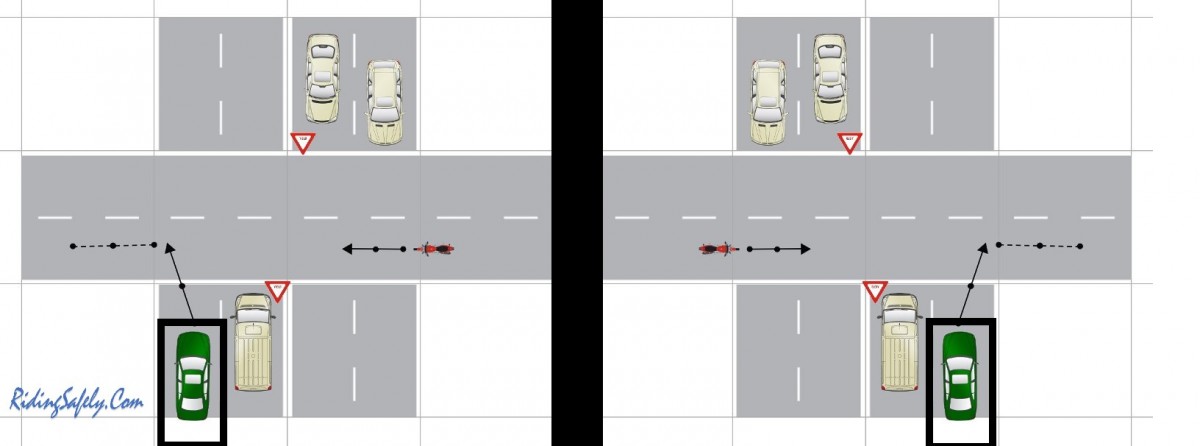
In the diagram. The red motorcycle has right of way. A green car that doesn’t see the motorcycle and pulls out in front of it from the blind spot, indicated by the black square, where it is hidden behind the yellow van.
- Slow Down and Get Ready because it is an intersection.
- Recognize the blind spot behind the stopped van, and direct sight it as you pass the van. Only when you see its clear do you go.
Notes. Again some might say “What can you do?” if a car does that. The answer is to not go where you can’t see the flows directly. When you direct sight, you don’t have to assume there is nothing there. If you think this is unlikely, check out this video of a car doing just this.
Driver lets another car out of a side road
In this case, a motorcycle overtaking a stream of stationary cars is unaware that one of the cars has left a gap and waved another car out from a side street.
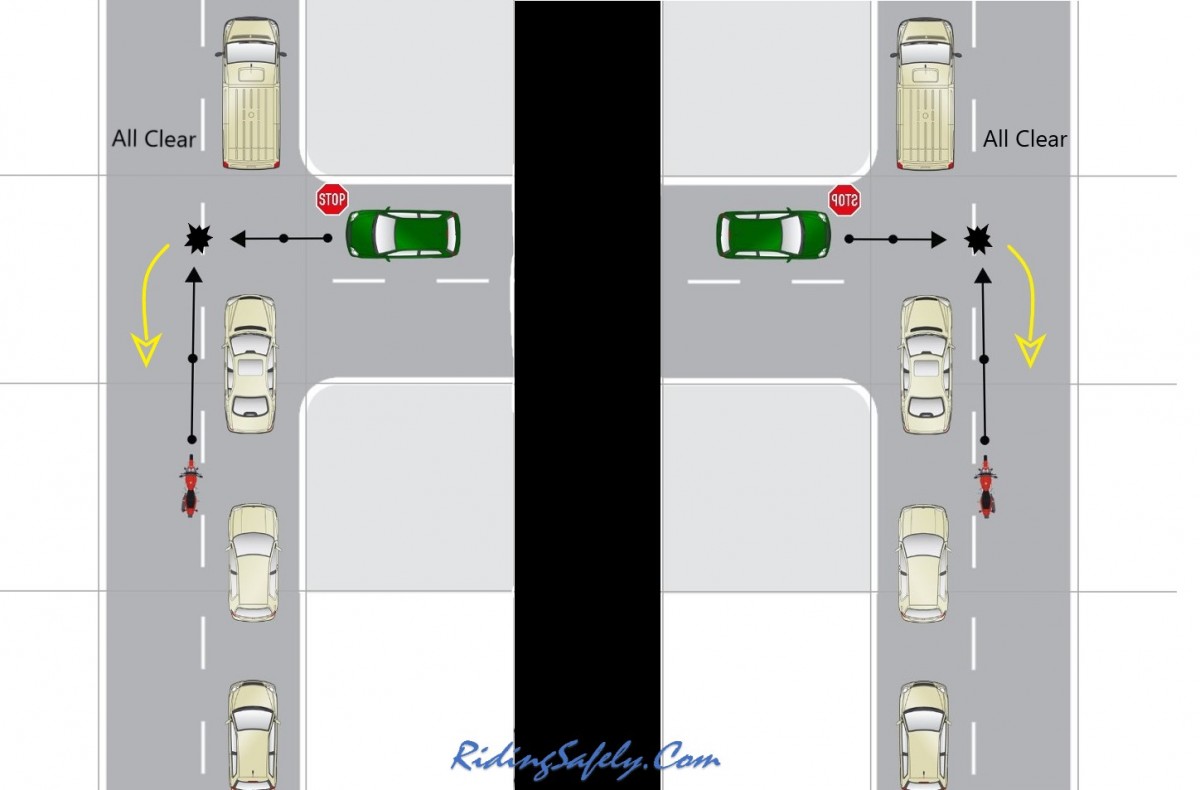
In the diagram. The motorcycle in red is overtaking stationary cars. The car in green is trying to pull out when a car in the stream kindly leaves a gap for them to do that. They pull out quickly, checking it is all clear for traffic coming the other way and dont see the motorcycle until they hit it. This is another variation of the Blind Spot case above, so the plan is the same. If you see any side street, that’s an intersection so slow down. Seeing the gap in the stream of stopped cars you recognize a blind spot and direct sight before proceeding, and so avoid a crash.
Overtaking at an intersection
This happens when new riders see a car stopped in the middle of the road apparently doing nothing and overtake it, then as they pass it the driver turns into them.
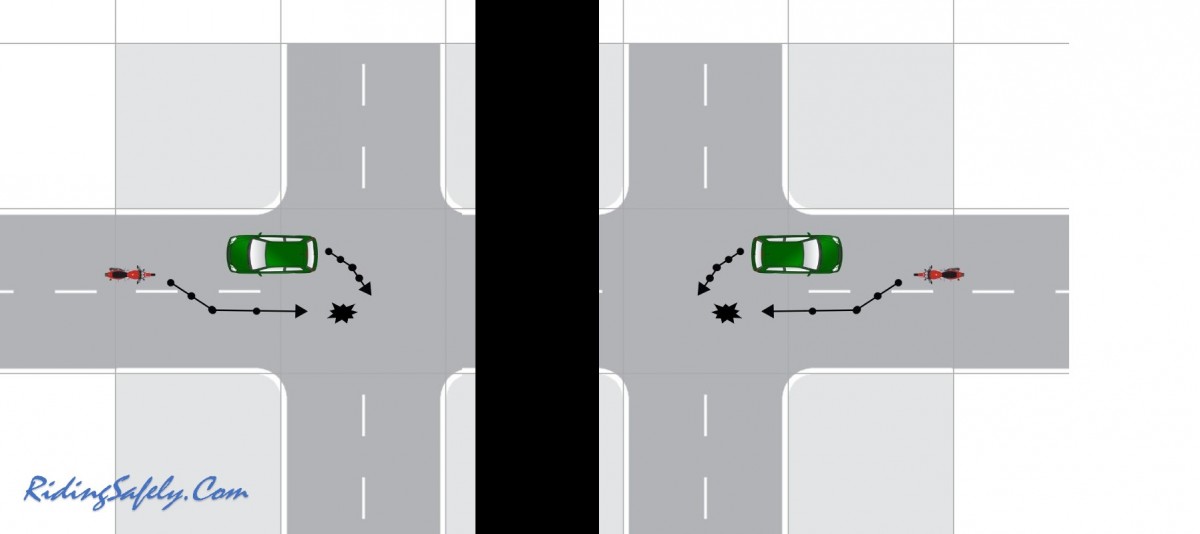
In the diagram. The motorcycle in red sees a stationary car in green not indicating and overtakes it. Maybe the car driver accidentally put their indicator on the wrong way and even checked their mirror. When asked later, they invariably say they didnt see the motorcycle. A car turning unexpectedly is not unusual car behavior, so you have to expect it. Remember, car drivers are never “doing nothing”, even when stationary. Second, never overtake at an intersection. Intersections are not about overtaking, they are about crashes. So just stay behind the car until it is obvious what it is going to do.
Lane kiss
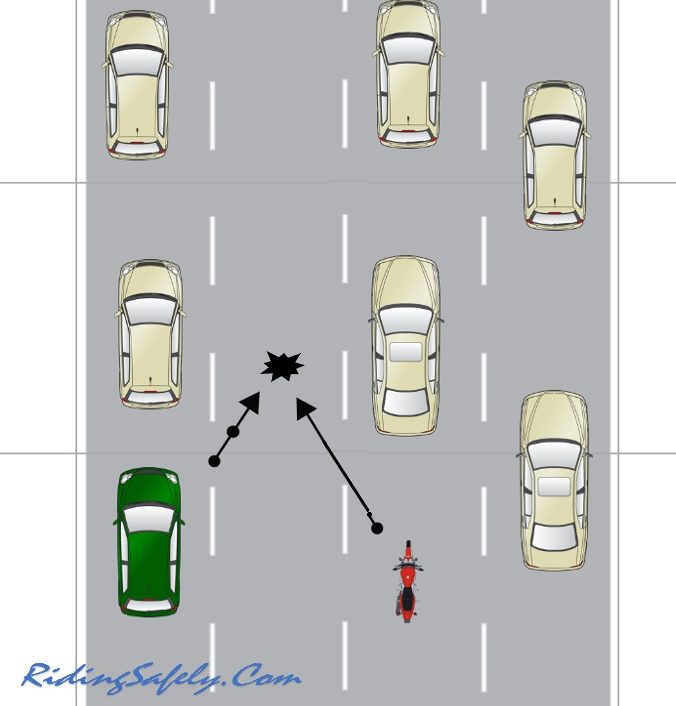
A lane kiss is when two vehicles decide to pull into a middle lane at the same time. Both check the lane is clear, and it is. Then both move into it at the same time to a near miss or collision.
In the diagram. The red motorcycle and the green car are both blocked in their lane. They both see that the lane between them is clear and both move into it at the same time. This doesnt happen often, but I assure you it does happen. I have had several cases over the years and seen others do it. You can predict the situation if you see another car stuck behind a slow car two lanes across, and so you wait and let them go. Otherwise you rely on a head turn and all-round scan and to see the car coming. If the scan feedback loop is always on, you see the other driver in your side vision as you turn into the lane. As motorcycles dont fully take up a lane, you can usually avoid a lane kiss. Cars are not so lucky.
Two lane roundabouts
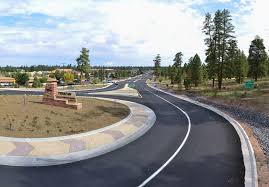
Two lane roundabouts occur when the roads leading into them have two lanes.The outside lane is supposed to be for a turning off the roundabout, and the inside lane is supposed to be for carrying on around the roundabout. But if you want to go round a bit and then turn off it gets tricky, and that’s when accidents occur. Two situations arise, as below.
- You are in the outside lane and a car on the inside lane suddenly decides to turn off the roundabout.
2. You are on the inside lane and the car outside you that should turn off decides to carry on around (see diagram).
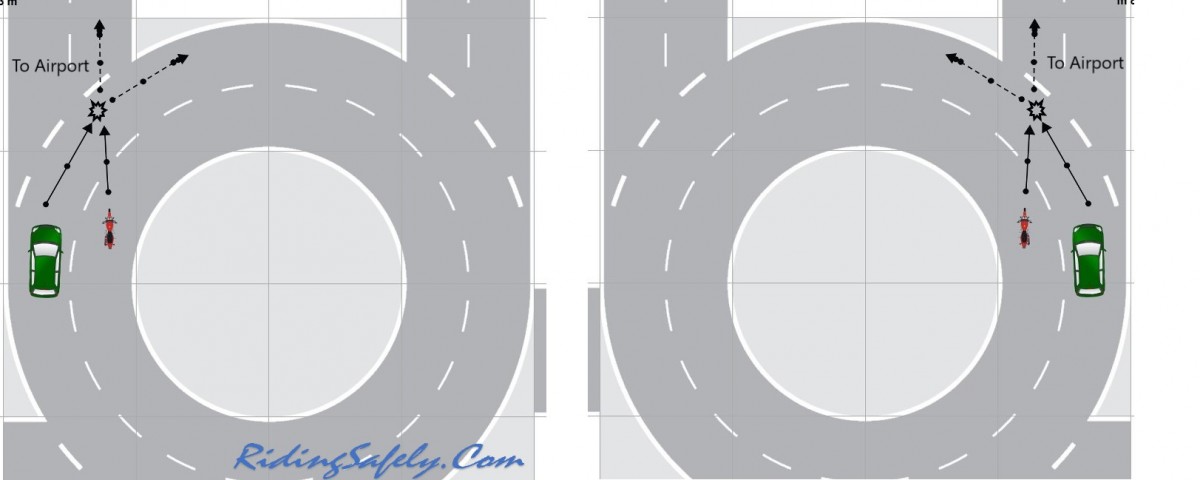
In both cases, under no circumstances travel alongside another vehicle going around a roundabout. Position yourself either in front or behind them and assume they cant see you. The diagram describes the case below.